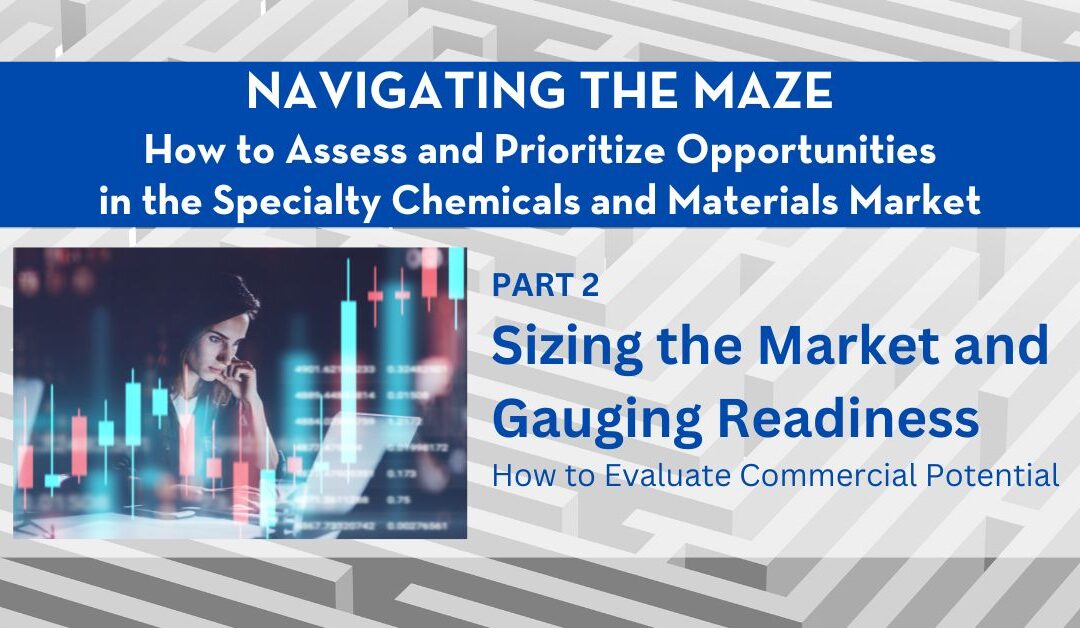Table of Contents
In the first post of this series, we explored the importance of building a strong interdisciplinary team as the foundation for evaluating opportunities in specialty materials. Now, we shift focus to two of the most critical pillars of opportunity assessment: market insight and commercial viability.
Without a firm grasp of the market landscape and the commercial realities of introducing a new product, even the most technically sound idea can fall flat. Let’s dive into how market and commercial analysis work together to identify where your next great opportunity lies.
Step 1: Understand Market Attractiveness
When assessing a potential opportunity in the specialty chemicals and materials industry, market size and growth are often the first metrics to consider, but they’re just the beginning. Key questions include:
- How large is the total addressable market (TAM)? This determines your overall potential revenue.
- What is the projected market growth rate? Is the segment expanding rapidly or maturing?
- What are the key trends and drivers? Green building standards, evolving environmental regulations, shift toward waterborne or bio-based coatings?
- What’s the competitive intensity? Are you up against major global players or niche formulators?
- How hard is it to enter the market? What are the regulatory barriers, distribution complexities, and formulation IP challenges?
Gathering this information requires a mix of secondary research, voice-of-customer (VOC) feedback, and input from your commercial team. It’s about more than size. It’s about accessibility, timing, and alignment with your strategic strengths.
Step 2: Evaluate Competitive Positioning and Differentiation
Even in large and growing markets, success depends on your ability to differentiate. Ask:
- What makes this product unique or better? More durable? Eco-certified?
- Is it just another me-too product, or does it solve a real pain point?
- Do customers value the difference enough to switch? Are you solving for cost, performance, or compliance?
Differentiation is especially important in markets where performance standards and service expectations are high. A strong value proposition must be relevant, validated, and clearly communicated.

Step 3: Assess Commercial Readiness
You’ve identified a promising market. Now assess whether your organization is commercially positioned to succeed. Consider:
- Do you already serve adjacent markets (e.g., protective, architectural, OEM)?
- Do you understand the application environment (e.g., temperature, surface prep, substrate)?
- Do you have the right channel partners (e.g., distributors, contractors, OEMs)?
- How long will it take to get spec’d in, tested, and approved by customers?
Sales cycles can be long, especially in regulated or performance-critical environments. Understanding how to navigate these hurdles early is key.
Example: Low-VOC Construction Adhesive
Let’s say your company is exploring a new low-VOC construction adhesive targeted at premium DIY and contractor markets. The overall market is large, but as you dig deeper, your team learns that many contractors remain skeptical of performance across the variety of substrates they routinely use. Your product has excellent lab performance but limited field validation.
Your commercial team also highlights that your brand is currently strong among DIY users but not contractors, and retail shelf space is already constrained. This insight doesn’t mean the project should be abandoned, but it might shift your entry strategy toward partnering with a retailer with excellent contractor services, including more contractor field validation and targeted contractor marketing.
Download the full
navigating the maze white paper
Integration with Interdisciplinary Teams
As with all parts of the opportunity assessment process, market and commercial evaluation should be integrated with your interdisciplinary team. Technical input helps ensure claims are feasible. Manufacturing insight determines lead times and costs. Finance evaluates margin potential and investment needs.
Bringing It All Together
Understanding market trends and customer needs is only one part of the equation. You also need to know whether your organization is positioned to compete and win. In the next post, we’ll explore technical feasibility and manufacturing readiness — two internal capabilities that are critical for delivering on your strategic vision.
To learn more, reach out to the author at cmorrison@chemquest.com.
How can we help you? Let’s start talking: https://chemquest.com/lets-start-talking/


